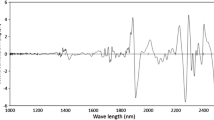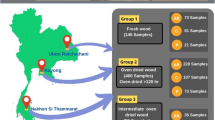Abstract
The moisture content (MC) of wood influences its material properties. Determination of MC is essential in both the research and manufacturing fields. This study examined a nondestructive method for estimating MC rapidly and effectively. A capacitance sensor and a near-infrared (NIR) spectrometer were used to measure the MC of Japanese cedar and Japanese cypress timber. High-frequency capacitance (20 MHz) and NIR spectral absorption (908–1676 nm) data were collected for cross section and tangential section, as well as for the whole-sample average, in two MC ranges: from the green to the fiber saturation point (FSP) and from FSP to air-dried state. The results indicated that when standard error of prediction (SEP) is compared, the performance in [FSP to air-dried state] was better; when coefficient of determination in cross-validation (\(R_{\text{val}}^{2}\)) and residual predictive deviation in cross-validation (RPDval) were compared, the performance in [Green to FSP] was better. Statistical analysis was performed using multiple linear regression and partial least squares. Combining capacitance and NIR absorbance at two wavelengths (Capacitance + NIR-MLR calibration) from the green to FSP was the best calibration yielding the most promising results: \(R_{\text{val}}^{2}\) = 0.96, SEP = 5.20% and RPDval = 4.97 on the cross section of samples. The results were higher than those of other calibrations in R2 and SEP and RPD values. The NIR-PLS calibration performed better than others with quite good R2, lower SEP and higher RPD in the MC range from FSP to air-dried state. The first calibration using only capacitance of wood was good in the first range of MC, but it is not good in the second range (R2 under 0.5). Depending on the MC range, the performance of each calibration was different. In both MC ranges, the results on the cross section were higher than on the tangential section due to the anisotropic characteristics of wood material. From Capacitance + NIR-MLR calibration, the predicted models were developed using multiple linear regression and logarithmic regression. Results suggest the possibility of developing a new portable device combining a capacitance sensor and NIR spectroscopy to accurately predict the MC of wood.





Similar content being viewed by others
References
Babiak MJ (1995) A contribution to the definition of the fiber saturation point. J Wood Sci Technol 29(3):217–226
Cooper PA, Jeremic D, Radivojevic S, Ung YT, Leblon B (2011) Potential of near-infrared spectroscopy to characterize wood products. Can J For Res 41(11):2150–2157. https://doi.org/10.1139/x11-088
Dahlen J, Diaz I, Schimleck L, Jones PD (2017) Near-infrared spectroscopy prediction of southern pine No. 2 lumber physical and mechanical properties. Wood Sci Technol 51(2):309–322
Defo M, Taylor AM, Bond B (2007) Determination of moisture content and density of fresh-sawn red oak lumber by near infrared spectroscopy. For Prod 57(5):68–72
Dietsch P, Franke S, Franke B, Gamper A, Winter S (2015) Methods to determine wood moisture content and their applicability in monitoring concepts. J Civ Struct Health Monit 5(2):115–127
Fujimoto T, Kobori H, Tsuchikawa S (2012) Prediction of wood density independent of moisture conditions using near infrared spectroscopy. Near Infrared Spectrosc 25:353–359
Haslett A, Williams D, Kininmonth J (1985) Drying of major cypress species grown in New Zealand. N Z J For Sci 15(3):370–383
Hein PRG, Campos ACM, Trugilho PF, Lima JT, Chaix G (2009) Near infrared spectroscopy for estimating wood basic density. Cerne, Lavras 15(2):133–141
Jiang JH, Berry RJ, Siesler HW, Ozaki Y (2002) Wavelength interval selection in multicomponent spectral analysis by moving window partial least-squares regression with applications to mid-infrared and near-infrared spectroscopic data. Anal Chem 74(14):3555–3565
Jouan-Rimbaud D, Walczak B, Massart DL, Last IR, Prebble KA (1995) Comparison of multivariate methods based on latent vectors and methods based on wavelength selection for the analysis of near-infrared spectroscopic data. Anal Chim Acta 304(3):285–295
Kabir MF, Daud WM, Khalid K, Sidek HAA (1998) Dielectric and ultrasonic properties of rubber wood. Effect of moisture content grain direction and frequency. Holz Roh Werkst 56:223–227
Karttunen K, Leinonen A, Saren MP (2008) A survey of moisture distribution in two sets of Scots pine logs by NIR-spectroscopy. Holzforschung 62(4):435–440
Kobori H, Inagaki T, Fujimoto T, Okura T, Tsuchikawa S (2015) Fast online NIR technique to predict MOE and moisture content of sawn lumber. Holzforschung 69(3):329–335
Mehmood T, Liland KH, Snipen L, Sæbø S (2012) A review of variable selection methods in partial least squares regression. Chemom Intell Lab Syst 118:62–69
Meyer L, Brischke C (2015) Fungal decay at different moisture levels of selected European-grown wood species. Int Biodeterior Biodegard 103:23–29
Milota MR (1994) Specific gravity as a predictor of species correction factors for a capacitance-type moisture meter. For Prod J 44(3):63–68
Nursultanov N, Altaner C, Heffernan WJB (2017) Effect of temperature on electrical conductivity of green sapwood of Pinus radiata (radiata pine). Wood Sci Technol 51(4):795–809
Pérez-Marín D, Fearn T, Guerrero J, Garrido-Varo A (2012) Improving NIRS predictions of ingredient composition in compound feedingstuffs using Bayesian non-parametric calibrations. Chemom Intell Lab Syst 110(1):108–112
Rantanen J, Räsänen E, Antikainen O, Mannermaa JP, Yliruusi J (2001) In-line moisture measurement during granulation with a four-wavelength near-infrared sensor: an evaluation of process-related variables and a development of non-linear calibration model. Chemom Intell Lab Syst 56(1):51–58
Savitzky A, Golay MJE (1964) Smoothing and differentiation of data by simplified least squares procedures. Anal Chem 36(8):1627–1639
Schimleck L, Mora C, Daniels R (2003) Estimation of the physical wood properties of green Pinus taeda radial samples by near infrared spectroscopy. Can J For Res 33(12):2297–2305
Stienen T, Schmidt O, Huckfeldt T (2014) Wood decay by indoor basidiomycetes at different moisture and temperature. Holzforschung 68(1):9–15
Tham VTH, Inagaki T, Tsuchikawa S (2018) A novel combined application of capacitive method and near-infrared spectroscopy for predicting the density and moisture content of solid wood. Wood Sci Technol 52(1):115–129. https://doi.org/10.1007/s00226-017-0974-x
Thybring EE (2013) The decay resistance of modified wood influenced by moisture exclusion and swelling reduction. Int Biodeterior Biodegard 82:87–95
Thybring EE, Kymäläinen M, Rautkari L (2018) Experimental techniques for characterising water in wood covering the range from dry to fully water-saturated. Wood Sci Technol 52(2):297–329
Tiitta M, Savolainen T, Olkkonen H, Kanko T (1999) Wood moisture gradient analysis by electrical impedance spectroscopy. Holzforschung 53(1):68–76
Tsuchikawa S, Kobori H (2015) A review of recent application of near infrared spectroscopy to wood science and technology. Wood Sci 61(3):213–220
Tsuchikawa S, Hayashi K, Tsutsumi S (1996) Nondestructive measurement of the subsurface structure of biological material having cellular structure by using near-infrared spectroscopy. Appl Spectrosc 50(9):1117–1124
Watanabe K, Kobayashi I, Kuroda N, Harada M, Noshiro S (2012) Predicting oven-dry density of Sugi (Cryptomeria japonica) using near infrared (NIR) spectroscopy and its effect on performance of wood moisture meter. Wood Sci 58(5):383–390
Wengert GAPB (1997) Evaluation of electric moisture meters on kiln-dried lumber. For Prod J 47(6):60–62
Wilson PJ (1999) Accuracy of a capacitance-type and three resistance-type pin meters for measuring wood moisture content. For Prod J 49(9):29–32
Windham W, Barton F, Robertson J (1988) Moisture analysis of forage by near infrared reflectance spectroscopy: preliminary collaborative study and comparison between Karl Fischer and oven drying reference methods. J Assoc Off Anal Chem 71:256–262
Xu Q, Qin M, Ni Y, Defo M, Dalpke B, Sherson G (2011) Predictions of wood density and module of elasticity of balsam fir (Abies balsamea) and black spruce (Picea mariana) from near infrared spectral analyses. Can J For Res 41(2):352–358
Yang Z, Liu Y, Pang X, Li K (2015) Preliminary investigation into the identification of wood species from different locations by near infrared spectroscopy. BioResources 10(4):8505–8517
Acknowledgements
This research was partly supported by the Research and Development Studies for Application in Promoting New Policy of Agriculture, Forestry, and Fisheries, Japan [No. 22003].
Author information
Authors and Affiliations
Corresponding author
Additional information
Publisher's Note
Springer Nature remains neutral with regard to jurisdictional claims in published maps and institutional affiliations.
Rights and permissions
About this article
Cite this article
Tham, V.T.H., Inagaki, T. & Tsuchikawa, S. A new approach based on a combination of capacitance and near-infrared spectroscopy for estimating the moisture content of timber. Wood Sci Technol 53, 579–599 (2019). https://doi.org/10.1007/s00226-019-01077-0
Received:
Published:
Issue Date:
DOI: https://doi.org/10.1007/s00226-019-01077-0




